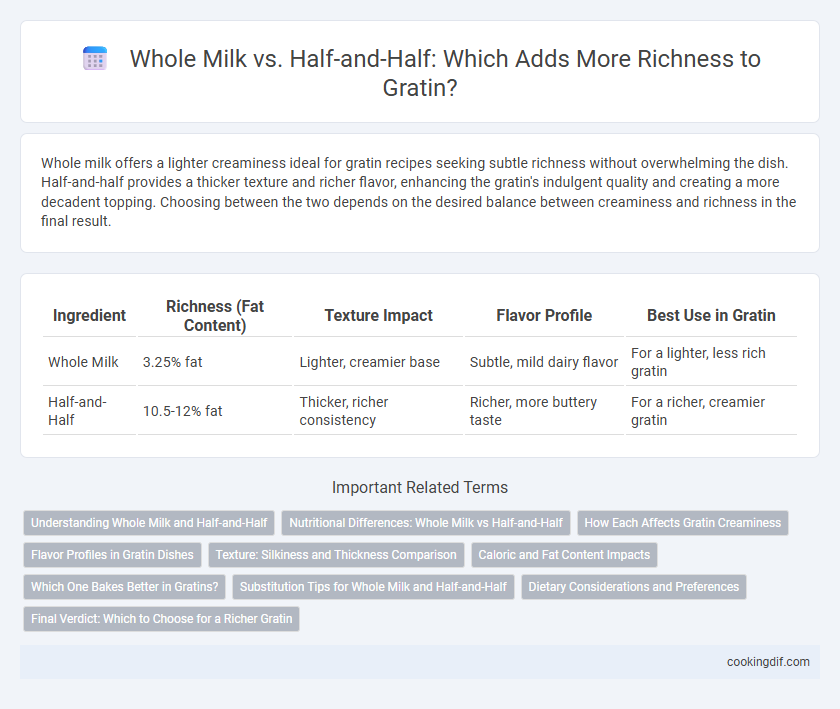Whole milk offers a lighter creaminess ideal for gratin recipes seeking subtle richness without overwhelming the dish. Half-and-half provides a thicker texture and richer flavor, enhancing the gratin's indulgent quality and creating a more decadent topping. Choosing between the two depends on the desired balance between creaminess and richness in the final result.
Table of Comparison
| Ingredient | Richness (Fat Content) | Texture Impact | Flavor Profile | Best Use in Gratin |
|---|---|---|---|---|
| Whole Milk | 3.25% fat | Lighter, creamier base | Subtle, mild dairy flavor | For a lighter, less rich gratin |
| Half-and-Half | 10.5-12% fat | Thicker, richer consistency | Richer, more buttery taste | For a richer, creamier gratin |
Understanding Whole Milk and Half-and-Half
Whole milk contains about 3.25% milk fat, providing a creamy texture ideal for gratin dishes without overwhelming richness. Half-and-half, a blend of milk and cream with 10-18% fat, offers a thicker consistency and richer mouthfeel, enhancing gratin's indulgence. Selecting whole milk results in a lighter gratin, while half-and-half intensifies creaminess and depth of flavor.
Nutritional Differences: Whole Milk vs Half-and-Half
Whole milk contains about 3.25% fat and provides essential nutrients like calcium, vitamin D, and protein, contributing moderate richness to gratin dishes. Half-and-half, blending roughly 10-12% fat from equal parts whole milk and cream, offers significantly higher creaminess and caloric content, enhancing gratin's texture and depth of flavor. Choosing half-and-half increases overall fat and calorie intake but delivers a richer mouthfeel and more pronounced taste contrast in baked gratins.
How Each Affects Gratin Creaminess
Whole milk offers a lighter creaminess in gratin, providing a subtle richness that allows the flavors of the cheese and vegetables to shine without overpowering the dish. Half-and-half delivers a thicker, more indulgent texture due to its higher fat content, creating a velvety, luscious sauce that enhances the gratin's luxurious mouthfeel. Choosing half-and-half over whole milk intensifies the dish's creaminess, resulting in a richer, more decadent gratin experience.
Flavor Profiles in Gratin Dishes
Whole milk provides a creamy texture with a mild, natural sweetness that enhances the subtle flavors in gratin dishes, while half-and-half offers a richer, more decadent taste due to its higher fat content. The increased fat in half-and-half contributes to a silkier mouthfeel and a more pronounced buttery flavor, making the gratin more indulgent. Choosing between whole milk and half-and-half depends on the desired balance between richness and lightness in the final gratin flavor profile.
Texture: Silkiness and Thickness Comparison
Whole milk provides a lighter texture with moderate silkiness, while half-and-half delivers a richer, creamier consistency ideal for gratin. The increased fat content in half-and-half enhances thickness and mouthfeel, creating a luxurious, velvety crust and smooth interior. Choosing half-and-half boosts overall richness, producing a more decadent gratin with superior texture depth.
Caloric and Fat Content Impacts
Whole milk contains approximately 150 calories and 8 grams of fat per cup, providing moderate creaminess to gratin dishes. Half-and-half offers increased richness with about 315 calories and 28 grams of fat per cup, resulting in a velvety texture and deeper flavor. Choosing half-and-half enhances the dish's caloric density and fat content, intensifying creaminess and mouthfeel compared to whole milk.
Which One Bakes Better in Gratins?
Whole milk offers a lighter texture with moderate creaminess, making gratins less dense but still flavorful. Half-and-half contains higher fat content, resulting in a richer, creamier gratin with a golden, bubbly crust. For optimal baking results, half-and-half enhances moisture retention and caramelization, producing a more indulgent and satisfying gratin.
Substitution Tips for Whole Milk and Half-and-Half
Whole milk provides a creamy base for gratin with moderate richness, while half-and-half offers a thicker, more luxurious texture due to its higher fat content, typically around 10-12%. When substituting whole milk for half-and-half, add a tablespoon of butter per cup to mimic the richness, or dilute half-and-half with a splash of water to lighten the mixture without losing creaminess. Adjusting the dairy component affects the gratin's consistency and flavor intensity, so balancing fat content is key for achieving the desired silky, golden crust.
Dietary Considerations and Preferences
Whole milk offers a lighter option with approximately 3.25% fat, making it suitable for individuals seeking moderate richness and lower calorie intake in gratin recipes. Half-and-half, with roughly 10-18% fat content, provides a creamier texture and richer flavor, preferred in traditional gratin preparation but higher in saturated fat. Dietary preferences and restrictions such as lactose intolerance or cholesterol concerns influence the choice, with whole milk being a more balanced option for health-conscious consumers.
Final Verdict: Which to Choose for a Richer Gratin
Whole milk provides a lighter, creamier base for gratin, preserving more subtle flavors while giving moderate richness. Half-and-half delivers a thicker, more luxurious texture with higher fat content, enhancing the gratin's golden crust and overall decadence. For a richer gratin, half-and-half is the preferred choice, creating a creamier, more indulgent dish.
Whole milk vs half-and-half for richness Infographic

 cookingdif.com
cookingdif.com